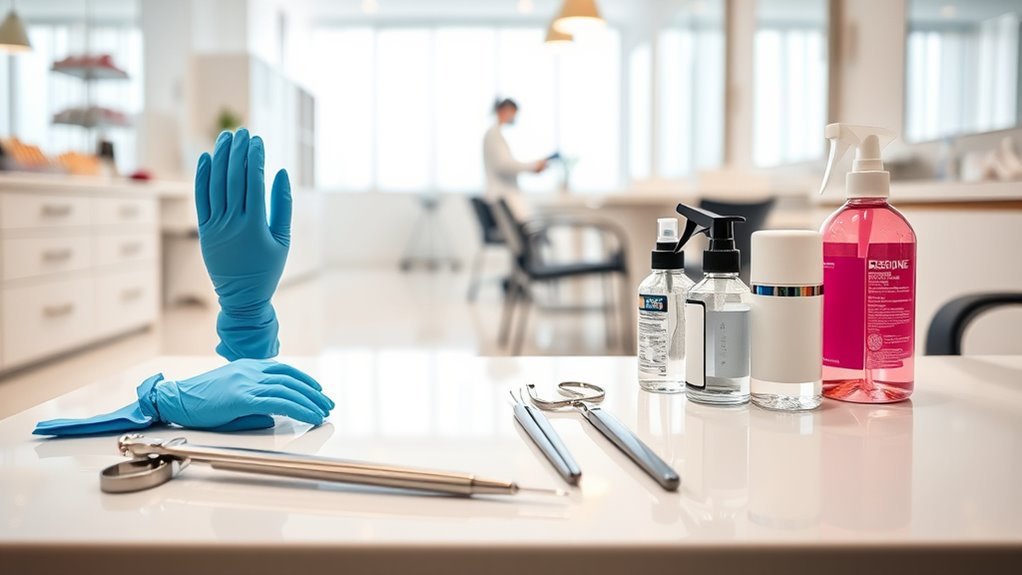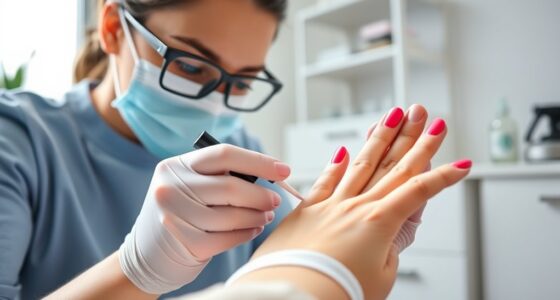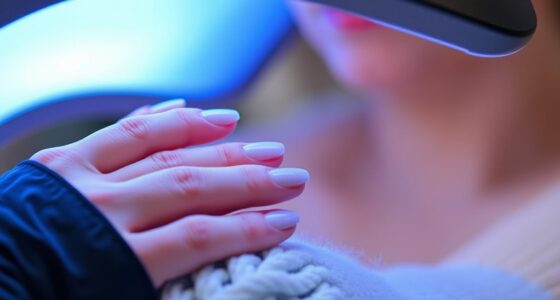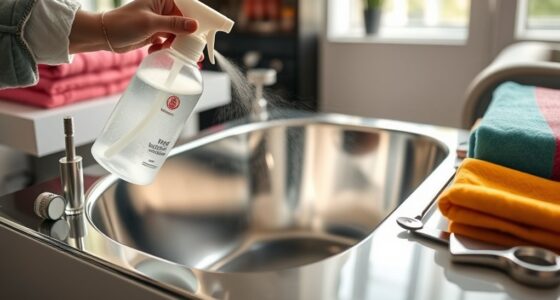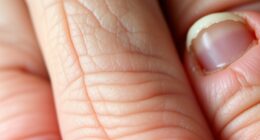To comply with nail salon sanitation regulations, you need to follow strict cleaning and sterilization routines. Use EPA-registered disinfectants for tools and surfaces, dispose of single-use items after each client, and sterilize reusable tools properly. Always wash your hands, wear gloves when necessary, and maintain a clean work environment. Keeping detailed records of disinfection procedures and staying updated on health guidelines helps guarantee safety and compliance. Keep going to discover more essential tips for maintaining a hygienic salon.
Key Takeaways
- Follow strict disinfection protocols for tools and surfaces using EPA-registered disinfectants to prevent cross-contamination.
- Dispose of single-use items after each client and sterilize reusable tools properly.
- Maintain detailed records of cleaning routines and sterilization processes for inspection readiness.
- Ensure personal hygiene by washing hands frequently and wearing gloves or masks when necessary.
- Stay updated on local health regulations through training and consultation with health departments to ensure compliance.

Ensuring proper sanitation in nail salons is essential for protecting both clients and staff from infections and health risks. When you visit a nail salon, you want to be confident that the environment meets strict sanitation standards and complies with current health regulations. These regulations are designed to minimize the risk of contamination, prevent the spread of bacteria and fungi, and keep everyone safe. As a professional working in the industry, it’s your responsibility to stay informed and adhere to these rules consistently.
First, understanding the importance of sanitation standards helps you maintain a safe and hygienic workspace. These standards dictate how tools, equipment, and surfaces should be cleaned, disinfected, and stored. For example, single-use items like files, buffers, and gloves must be disposed of after each client, while reusable tools like scissors and cuticle pushers require proper sterilization. You need to follow prescribed disinfecting procedures, using EPA-registered disinfectants that are effective against viruses and bacteria. This not only meets legal requirements but also reassures clients that their health is a priority. Proper disinfection procedures are vital for preventing cross-contamination and ensuring safety.
Health regulations set clear guidelines for maintaining a safe environment. They specify the frequency of cleaning routines, proper waste disposal, and personal hygiene standards for staff. For instance, hands should be washed thoroughly between clients, and staff should wear gloves and masks when necessary. Proper ventilation and clean workstations are also mandated to reduce airborne contaminants. Adhering to these regulations is critical because failure to comply can lead to legal penalties, closure of the salon, or a damaged reputation. Regular staff training on these health regulations ensures everyone understands their role in upholding sanitation protocols.
You should also keep detailed records of disinfection routines, equipment sterilization, and cleaning schedules. This documentation demonstrates your commitment to compliance and can be useful during inspections. Regular audits or internal checks help identify areas needing improvement, making sure sanitation standards are always met. Additionally, staying updated on any changes in health regulations is crucial, as laws evolve with new health threats or scientific findings. Participating in industry training sessions or consulting local health departments will keep you informed.
Frequently Asked Questions
How Often Are Nail Salon Sanitation Inspections Conducted?
You might wonder about inspection frequency at nail salons. Typically, health departments conduct sanitation inspections periodically, often every six months to a year, depending on local regulations. These inspections guarantee nail salons meet sanitation standards, preventing infections and ensuring safety. Regular inspections help maintain high standards, so you can feel confident that your salon follows proper sanitation protocols. Stay informed about your local regulations for specific inspection schedules in your area.
What Should I Do if a Salon Fails Sanitation Standards?
Imagine discovering your favorite nail salon failed sanitation standards—that’s unsettling. First, follow salon complaint procedures by reporting health violations to local health authorities. Document your concerns with photos if possible. Don’t delay—report the issue promptly to guarantee proper inspection and action. Your proactive steps help protect others and uphold sanitation standards, creating a safer environment for everyone. Stay vigilant and speak up when you see violations; your voice matters.
Are There Specific Sanitation Regulations for Pedicure Bowls?
You should always follow strict pedicure hygiene practices, especially for pedicure bowls. Regulations require you to thoroughly clean and disinfect bowls after each use, ensuring proper bowl sterilization. Use EPA-registered disinfectants and follow manufacturer instructions for contact time. Regularly inspect your sanitation procedures to prevent bacteria buildup. Maintaining these standards not only keeps clients safe but also complies with health regulations, protecting your salon’s reputation.
Do Sanitation Rules Vary by State or City?
Your question about sanitation rules is as essential as a lighthouse guiding ships. State regulations and city guidelines often differ, creating a patchwork of standards across the country. You need to stay updated on local laws to guarantee your salon meets all requirements. Ignoring these variations can lead to serious health risks and legal trouble. Always check with local authorities or industry associations for the most current sanitation regulations in your area.
How Can Clients Verify a Salon’s Sanitation Compliance?
You can verify a salon’s sanitation compliance by asking to see their sanitation certification, which shows they meet health standards. Observe customer hygiene practices, like clean tools and proper handwashing. Don’t hesitate to ask staff about their cleaning routines or request new tools for each client. A reputable salon prioritizes hygiene, so their certification and cleanliness practices should be transparent and evident during your visit.
Conclusion
By following these sanitation rules, you’re not just protecting your nails—you’re safeguarding your well-being like a shield of trust. Think of proper sterilization as a lighthouse guiding you safely through the stormy seas of bacteria and germs. When salons prioritize cleanliness, they’re planting seeds of confidence and health in your path. Remember, a well-maintained space isn’t just about appearances; it’s a symbol of respect for your health, shining brightly like a beacon of safety in every visit.
